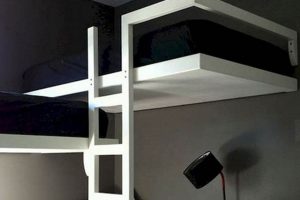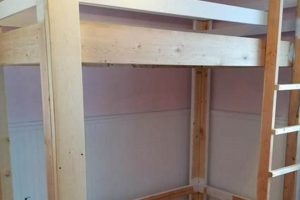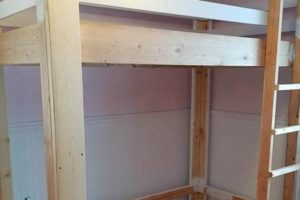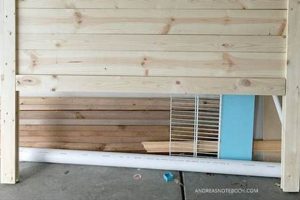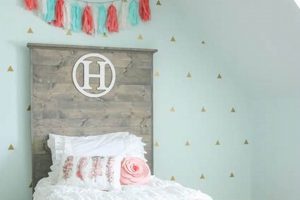Creating a sleeping space that integrates seamlessly into a living area, maximizing functionality in compact environments, involves a specific category of projects. These projects often involve repurposing existing furniture or building new structures to conceal a bed when not in use. Examples include transforming a cabinet into a pull-down bed or constructing a platform bed that slides away under a raised floor.
The appeal of space-saving sleeping solutions lies in their ability to enhance living areas, particularly in apartments, studios, or multi-purpose rooms. Historically, these designs address the challenges of limited square footage, offering a blend of aesthetics and practicality. By effectively managing space, the design contributes to improved organization and a sense of openness.
The subsequent sections will delve into the various types of these space-saving bed projects, the materials typically required, and a breakdown of the construction processes involved. Furthermore, this exploration will consider potential design considerations and safety aspects that warrant attention.
Tips for Space-Saving Bed Projects
The successful execution of a project to create a space-saving bed hinges on careful planning and precise execution. The following guidelines offer valuable insights for individuals embarking on this endeavor.
Tip 1: Thoroughly Assess Spatial Dimensions: Prior to initiating construction, meticulously measure the intended space. Account for all dimensions, including ceiling height and any potential obstructions, to ensure the mechanism functions flawlessly and integrates seamlessly with the room’s layout.
Tip 2: Prioritize Mechanism Reliability: The bed’s folding or sliding mechanism is paramount. Invest in high-quality hardware designed for repeated use. Test the mechanism thoroughly before completing the project to identify and rectify any potential points of failure.
Tip 3: Select Appropriate Materials for Durability: Choose robust materials that can withstand the stresses of regular use. Solid wood or high-quality plywood are recommended for the bed frame and supporting structures. Consider the weight capacity of the chosen materials to ensure the bed’s stability and longevity.
Tip 4: Integrate Safety Features: Implement safety latches or locking mechanisms to prevent unintentional deployment of the bed. Ensure the hardware used is appropriately rated for the load and that all connections are secure.
Tip 5: Optimize for Accessibility and Ease of Use: The design should prioritize user-friendliness. Consider features such as integrated handles or levers to facilitate effortless opening and closing. Avoid designs that require excessive force or awkward maneuvers.
Tip 6: Incorporate Aesthetic Harmony: Strive for a design that complements the existing decor. Conceal the bed within a cabinet or other furniture piece that aligns with the room’s style. Pay attention to details such as hardware finishes and paint colors to create a cohesive aesthetic.
Tip 7: Consult Structural Engineering Expertise (If Necessary): For complex designs or when integrating the bed into existing structural elements, seek guidance from a qualified structural engineer. This is especially crucial when modifying load-bearing walls or floors.
Adhering to these guidelines will significantly enhance the likelihood of a successful outcome, resulting in a functional and aesthetically pleasing space-saving bed solution. The following sections will provide more detail about where and when to start.
1. Spatial Efficiency
Spatial efficiency, in the context of a concealed bed project, constitutes the degree to which the design maximizes usable space within a given area. The fundamental cause of implementing a hidden bed design is often the constraint of limited square footage. The effect is a multi-functional space where a bedroom transforms into a living area, office, or other usable room. The importance of spatial efficiency is that it allows small properties to be more usable and comfortable. For example, an apartment or studio that would otherwise require dedicating a significant portion to a bed can instead be a more functional living area during the day.The bed disappears when not needed, giving that space back to be used for other activities.
Practical significance manifests in increased property value and enhanced quality of life.Consider a small home office. A hidden bed, such as a wall-mounted Murphy bed, enables the room to serve as a guest room when needed. This eliminates the necessity for a dedicated guest room, thus freeing up valuable square footage for other purposes. Another example is that a smaller home is more easily kept clean and maintained, saving time and money. This dual functionality exemplifies the design’s contribution to spatial optimization. Space savings is a cost savings.
The connection between spatial efficiency and these projects is direct and vital. Hidden bed projects solve spatial challenges. Maximizing spatial utility transforms constrained areas into flexible living spaces. While challenges may arise in the form of complex mechanics or custom construction, the benefits of optimizing limited space consistently underscore the value of these types of builds.
2. Mechanism Reliability
Mechanism reliability is a paramount consideration within the realm of space-saving bed projects. The consistent and predictable operation of the bed’s deployment and retraction mechanism directly impacts the utility, safety, and overall user experience. A compromise in mechanism reliability can negate the spatial benefits, introducing inconvenience and potential hazards.
- Hinge Integrity
The hinges are primary points of articulation. They bear the entire weight of the bed during operation and when deployed. High-quality hinges, constructed from robust materials such as steel with appropriate weight ratings, are essential. Failure in this component can lead to sudden collapse or jamming, posing significant safety risks. For example, a cheap hinge could buckle and break under the regular stress of the mattress, resulting in a jammed bed.
- Locking and Support Systems
Locking mechanisms ensure the bed remains securely stowed when not in use, preventing accidental deployment. Support systems provide stability during use, preventing sagging or instability. The quality and design of these systems are directly linked to user safety and long-term functionality. For instance, the support system could be a hydraulic strut. If not properly sized for the bed, it would result in difficult operation. Or, in extreme cases, it could damage the locking system.
- Counterbalance Mechanisms
Counterbalance mechanisms, such as springs or gas struts, are frequently employed to reduce the effort required to raise and lower the bed. The effectiveness and durability of these components are vital for ease of use. Furthermore, a poorly designed mechanism could result in uneven wear and tear, ultimately leading to premature failure. Counterbalance that works initially will wear out as time passes and eventually needs to be replaced. If this is not accounted for in the design, the operation will be difficult to impossible.
- Frame Rigidity and Material Selection
The overall rigidity of the bed frame contributes significantly to mechanism reliability. Flex or distortion in the frame can place undue stress on the mechanism, accelerating wear and tear. Selecting appropriate materials, such as hardwood or high-gauge steel, and employing robust construction techniques are crucial for maintaining structural integrity. Soft wood or thin steel would bend under the weight of the bed and the forces put upon it by the mechanism.
These considerations underscore the integral role of mechanism reliability in space-saving bed solutions. Prioritizing high-quality components and sound engineering principles is not merely a matter of convenience but a necessity for ensuring safety, longevity, and the realization of the intended spatial benefits. Poor design choices can lead to user frustration and, more seriously, physical harm, detracting from the intended purpose of these innovative space-saving designs.
3. Material Durability
Material durability stands as a critical factor in the design and longevity of space-saving bed projects. The concealed nature and often complex mechanisms of these beds subject the materials used to unique stresses. Selecting materials appropriate for the intended load-bearing and operational demands is paramount. The cause-and-effect relationship is direct: insufficient material durability results in structural failure, reduced lifespan, and potential safety hazards. The importance of material choice is underscored by the fact that a collapsing bed could cause serious injury.
Practical applications further illustrate this point. Solid hardwoods, such as maple or oak, offer superior resistance to bending and wear compared to engineered woods like particleboard. While hardwoods carry a higher initial cost, their long-term performance and stability translate to greater value. Similarly, metal components, especially those involved in the folding or sliding mechanisms, must be of high-grade steel with adequate thickness to withstand repeated stress cycles. For instance, a Murphy bed utilizing low-quality hinges is prone to sagging or complete detachment from the wall, rendering the bed unusable and potentially dangerous. A contrasting example might involve selecting high-density plywood for a platform bed frame. The multi-layered construction resists warping and provides a stable base for the mattress, ensuring long-term durability. The right materials ensure that the mechanism works as intended without deforming the supporting structure.
In summary, material durability is not merely a desirable attribute but a prerequisite for successful space-saving bed constructions. Careful consideration of material properties, load-bearing capacity, and resistance to wear and tear is crucial for maximizing the bed’s lifespan, ensuring user safety, and achieving the intended spatial benefits. Design compromises based solely on cost savings can ultimately prove detrimental, leading to premature failure and negating the initial investment in the project. Prioritizing high-quality, durable materials is integral to the overall success and practicality of any space-saving bed endeavor.
4. Safety Latches
Safety latches constitute a non-negotiable component in the design and implementation of hidden bed systems. Their primary function is to prevent unintended deployment of the bed, mitigating potential hazards. The absence of reliable safety latches introduces a significant risk of injury and property damage. The importance of their role derives from the inherent mechanical nature of hidden beds, where gravity and stored energy within the mechanism can cause the bed to unfold unexpectedly.
The practical application of safety latches ranges from simple mechanical catches to more sophisticated locking mechanisms. A common example involves a spring-loaded pin that engages when the bed is stowed, requiring deliberate release to initiate lowering. Another example uses a two-step release, preventing accidental tripping of the latch. Inadequate latch design, using weak materials or relying on friction alone, compromises safety. Conversely, a robust latching system, employing hardened steel and a positive locking action, provides a secure hold, minimizing the likelihood of unintended movement. Furthermore, integrating a secondary safety mechanism offers an additional layer of protection. Regular inspection and maintenance of the safety latches are essential to ensure their continued functionality. The latch must be able to withstand the forces put upon it when the bed is stowed away. A weak latch would fail over time due to stresses, and may even fail all at once, which would be a hazard.
In conclusion, safety latches are integral to the safe operation of any hidden bed solution. Prioritizing robust design, durable materials, and regular maintenance of these latches is crucial for mitigating the risks associated with unintentional bed deployment. Neglecting this critical aspect compromises user safety and undermines the intended benefits of a space-saving design. Design choices that prioritize aesthetics or cost over safety considerations are fundamentally flawed and potentially dangerous. The overall success of a hidden bed project relies heavily on the reliability and effectiveness of its safety mechanisms.
5. Design Integration
Design integration, concerning space-saving bed projects, reflects the harmonious blending of the bed’s functional aspects with the existing aesthetic and architectural elements of the surrounding space. The primary cause for emphasizing design integration stems from the need to avoid visual dissonance; a poorly integrated bed can disrupt the room’s overall ambiance and reduce its perceived value. The effect of successful integration is a seamless transformation, where the bed enhances rather than detracts from the room’s appeal. Its importance lies in maintaining the intended aesthetic intent of the room, even with the incorporation of a space-saving bed.
Examples of design integration encompass various strategies. A Murphy bed concealed within a custom-built bookcase, matching the room’s existing shelving, represents a common approach. Color palettes, hardware finishes, and architectural details are meticulously aligned to create visual consistency. Another example involves integrating a platform bed that slides under a raised floor, with the platform surface mirroring the flooring material of the main area. This continuity minimizes the bed’s visual impact when stowed. From a practical perspective, achieving effective design integration requires careful planning, attention to detail, and consideration of existing design themes. It may involve custom fabrication or modification of existing furniture to ensure a unified appearance.
Design integration presents challenges, including matching existing finishes, accommodating structural limitations, and balancing aesthetic goals with budget constraints. Despite these challenges, the benefits of a well-integrated space-saving bed are considerable, contributing to a more cohesive and visually appealing living environment. Effective integration elevates the functionality of the space-saving bed into a beautiful addition rather than an afterthought.
6. Cost Effectiveness
Cost effectiveness, in the context of creating space-saving bed solutions, is a crucial determinant of project feasibility and overall value. The pursuit of space maximization must be balanced against budgetary considerations to ensure a financially sound outcome. The cause is the need to use space efficiently. The effect, however, should not be financial difficulty from the process. The importance of cost effectiveness lies in its ability to democratize space-saving solutions, making them accessible to a wider range of individuals and households. Projects with uncontrolled costs often remain unrealized, limiting their potential benefits.
Practical significance manifests in a careful evaluation of material choices, labor requirements, and mechanism selection. For instance, opting for locally sourced lumber over imported hardwoods can significantly reduce material costs without necessarily compromising structural integrity. Similarly, repurposing existing furniture or employing basic construction techniques can minimize the need for specialized labor. Choosing a gas-spring mechanism, which is known for its reliability, can be cheaper than a torsion-spring mechanism, which can be difficult to install and repair, saving not just the initial cost, but also preventing future costs. A further example, consider comparing the cost of a prefabricated Murphy bed kit with a custom-built design. While the kit may offer convenience, the custom design allows for greater flexibility in material selection and dimensions, potentially leading to cost savings and a more tailored solution. Cost estimates are essential to ensure a project is viable.
In summary, cost effectiveness is not a compromise on quality or safety but a strategic approach to resource allocation. Thorough planning, informed decision-making, and a willingness to explore alternative solutions are essential for achieving a cost-effective space-saving bed project. While budgetary constraints may present challenges, they also foster innovation and resourcefulness, ultimately contributing to more accessible and sustainable space-saving solutions. Budget consciousness, tempered by design consideration, is best.
Frequently Asked Questions
The following addresses common queries related to the design, construction, and safety aspects of space-saving bed projects. The information provided aims to offer clarity and guidance based on established principles and best practices.
Question 1: What types of space-saving bed configurations are generally considered feasible?
Common configurations include wall-mounted (Murphy) beds, platform beds with integrated storage or slide-away mechanisms, and folding beds incorporated into existing furniture pieces. The feasibility of each configuration depends on spatial constraints, structural considerations, and user requirements.
Question 2: What are the key structural considerations when implementing a wall-mounted bed?
Wall-mounted beds require secure attachment to structural studs or a load-bearing wall. The wall’s capacity to support the bed’s weight, particularly when deployed, must be assessed. Proper anchoring hardware and reinforcement may be necessary to ensure structural integrity.
Question 3: What safety measures are essential for all space-saving bed projects?
Essential safety measures include reliable locking mechanisms to prevent unintended deployment, robust support systems to ensure stability during use, and adherence to recommended weight limits. Regular inspection and maintenance of all components are also crucial.
Question 4: What materials are typically recommended for constructing a durable space-saving bed frame?
Solid hardwoods, high-quality plywood, and steel are commonly recommended for bed frames. Material selection should consider load-bearing capacity, resistance to warping, and overall durability. Avoidance of low-density particleboard or inferior metals is advised.
Question 5: Is professional assistance typically required for these types of construction projects?
The need for professional assistance depends on the project’s complexity and the individual’s skill level. Complex designs, structural modifications, or electrical integrations may warrant consulting with qualified contractors, engineers, or electricians.
Question 6: What are the common challenges associated with integrating a space-saving bed into an existing space?
Common challenges include matching existing finishes, accommodating spatial limitations, and ensuring the bed’s design complements the room’s overall aesthetic. Careful planning, accurate measurements, and attention to detail are crucial for overcoming these challenges.
Space-saving bed projects present a viable solution for optimizing living spaces. Careful planning, adherence to safety protocols, and informed decision-making are essential for successful implementation.
The subsequent sections will delve into the practical considerations for choosing the optimal location for a space-saving bed installation.
Conclusion
This exploration has demonstrated the complexities and considerations inherent in executing a “hidden bed diy” project. From spatial efficiency and mechanism reliability to material durability and safety latches, the successful integration of these space-saving solutions demands careful planning and precise execution. Design integration and cost-effectiveness further influence the overall viability and value proposition.
The decision to undertake a “hidden bed diy” endeavor warrants a comprehensive assessment of skills, resources, and design goals. While the potential for enhanced spatial utility is significant, neglecting fundamental safety principles or underestimating structural requirements carries substantial risk. Therefore, prospective builders are encouraged to prioritize thorough research, meticulous planning, and, when necessary, professional consultation to ensure a safe, functional, and aesthetically pleasing outcome.


